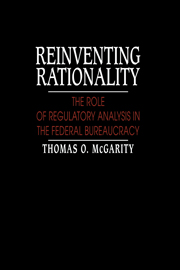Book contents
- Frontmatter
- Contents
- Acknowledgments
- Abbreviations
- Introduction
- Part I The clash of regulatory cultures
- Part II Regulatory analysis in theory and practice
- 3 Getting the lead out of gasoline: EPA's lead phasedown regulations
- 4 Getting the dust out of the air: EPA's ambient air quality standard for particulate matter
- 5 Getting obstructions out of the driver's view: NHTSA's field of direct view regulations
- 6 Getting the bone out of processed meat: FSIS's mechanically separated meat standard
- 7 Getting information into hazardous workplaces: OSHA's hazard identification regulations
- 8 The virtues of regulatory analysis
- 9 Limitations of regulatory analysis
- 10 Regulatory analysis in the real world
- Part III Structuring regulatory analysis into the decisionmaking process
- Part IV Review of regulatory analysis
- Part V Conclusions
- Notes
- Bibliography
- Index
4 - Getting the dust out of the air: EPA's ambient air quality standard for particulate matter
Published online by Cambridge University Press: 16 October 2009
- Frontmatter
- Contents
- Acknowledgments
- Abbreviations
- Introduction
- Part I The clash of regulatory cultures
- Part II Regulatory analysis in theory and practice
- 3 Getting the lead out of gasoline: EPA's lead phasedown regulations
- 4 Getting the dust out of the air: EPA's ambient air quality standard for particulate matter
- 5 Getting obstructions out of the driver's view: NHTSA's field of direct view regulations
- 6 Getting the bone out of processed meat: FSIS's mechanically separated meat standard
- 7 Getting information into hazardous workplaces: OSHA's hazard identification regulations
- 8 The virtues of regulatory analysis
- 9 Limitations of regulatory analysis
- 10 Regulatory analysis in the real world
- Part III Structuring regulatory analysis into the decisionmaking process
- Part IV Review of regulatory analysis
- Part V Conclusions
- Notes
- Bibliography
- Index
Summary
One of EPA's most important functions under the Clean Air Act is to promulgate and revise National Ambient Air Quality Standards (NAAQSs) for ubiquitous air pollutants. The primary NAAQS for a pollutant specifies an ambient concentration of the pollutant (expressed as micrograms of pollutant per cubic meter of air (μg/m3)) that will protect the public health (including the health of susceptible groups such as infants, asthmatics and the elderly) with an adequate margin of safety. A secondary NAAQS is set at a level sufficient to protect the public welfare. In setting the primary standards, EPA examines the human health effects of pollutants, while secondary standards focus on effects on wildlife, visibility, crops, man-made materials, and the general ecology. States must write State Implementation Plans (SIPs) that impose emissions limitations on individual sources sufficient to meet the NAAQSs by specified deadlines.
Regulatory background
One of the very first NAAQSs was for “total suspended particulates” (TSP), a generic term that refers to any particles that stay in suspension in the air long enough to be captured by a designated measuring device. This includes a wide variety of solid and liquid particles that vary widely in size, stability and toxicity. Particulate matter from coke ovens and diesel trucks contains highly carcinogenic poly cyclic aromatic hydrocarbons; particulate matter from West Texas cotton fields is mostly composed of relatively harmless silicates. Congress in 1977 told EPA to reevaluate the TSP NAAQSs by 1980 and at five-year intervals thereafter.
The March 209 1984 Proposal
EPAs first step in revising the particulates NAAQS was to prepare a criteria document setting out the available health and welfare information about the pollutant.
- Type
- Chapter
- Information
- Reinventing RationalityThe Role of Regulatory Analysis in the Federal Bureaucracy, pp. 45 - 61Publisher: Cambridge University PressPrint publication year: 1991



